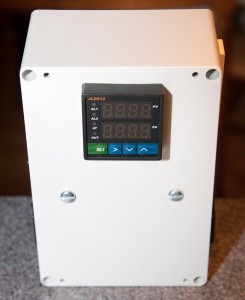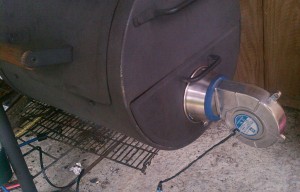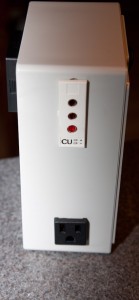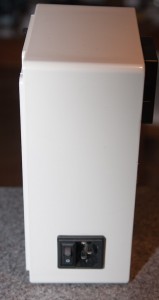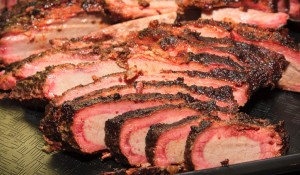Seth's House
DIY PID Control for BBQ, Sous Vide, Mash Tun, whatever….
(update: go HERE for a 12 volt BBQ controller!)
I’ve been slacking on the blog, I know, been busy!
Here’s a project that’s been in the works for a while, and I wanted to test it out to make sure it works well before sharing with everyone.. well, here it is! A DIY PID controller for a smoker, sous vide cooking, mash tun, whatever you can think of, that doesn’t break the bank. After a few runs in the smoker and sous vide (a la crockpot), I can say, it’s awesome !!!!
What is PID? Basically you tell it what temperature you want something, and it figures out how to hold that temperature. It’s nerdy and involves lots of math. I can’t explain it too well, so go and read about it here.
When I set out to build this, I wanted to keep costs down (obviously), but I wanted it to be versatile, so I decided to build everything with modular plugs, so that thermocouples and outputs could be swapped in a matter of seconds. Everything fits into a project box, and all you do is plug in power (input), a thermocouple (thermometer for you noobs), and then plug in an output device, whether it is a blower fan, a crock pot, a heating element, whatever. All of the components in my design are good for 15 amps, so a ~1500 watt heating element should be no issue. Wiring is simple and contained completely within the project box. I chose to do a simple design for the first incarnation of this device, but I have some ideas for another one. The PID controller has alarm outputs (such as over/under temperature) that could potentially control other items, such as a damper to release extra heat in the smoker, outputs to my X10 devices to page me, etc… the possibilities are endless.
Parts List
- 1x JLD612 PID Controller – $33.50 US
- 1x Submersible thermocouple – $19.50 US – this is for Sous Vide only
- 1x PT100 thermocouple – $16.50 US – this is mounted in my smoker
- 1x ESSR-25DAC 25amp DC in / AC Out Solid State Relay (SSR)- $8.95 US
- 1x EHS-SSR25A heat sink for the SSR – $4.25 US
- 1x TPJ-U-F thermocouple panel jack – $4.50 US
- 2x OTP-U-M thermocouple male plug – $3.50 US each (only need one per thermocouple
- 1x 486-1083-ND – female NEMA-15 outlet (output outlet) – $1.42 US
- 1x CCM1909-ND – power entry module w/ switch (input) – $7.66 US (you can go with a more simple input plug without a switch, but I wanted a switch on mine, and these fit your standard computer power wires)
- 1x HM928-ND project box – $17.82 US – Digikey’s site is very easy to search, if you need a bigger box, then look around – just make sure the dimensions are deep enough for all of your components.
- 1x 1053-1118-ND 14CFM blower fan – you can go bigger or smaller, this one seems to work great on my Chargriller
- 2x Barrier strips, at least 3 positions – like these – don’t forget the jumpers
- 1x stainless steel pet water bowl, to mount the fan to the BBQ – see picture. Found it at Walmart for a few bucks
- Various M4 screws, to mount SSR heatsink to the SSR. Take them both with you to Lowe’s/Home Depot and figure it out
- Heat sink paste for the SSR
- Various quick disconnect crimp connectors. If you have a well stocked electrical connector box for automotive stuff, that will get you through it
- Hot glue gun to mount components like the barrier strips
- Dremel tool / drill, to mount everything in the box
Wiring
Wiring is pretty easy – you can see most of it in the picture. Use at least 14ga on the 120volt stuff. The DC is low current, but I still used 16gauge because that’s what I had around. Thermocouple wiring comes with the thermocouples, I just changed the connectors. Specific wiring info:
- For 120v – the hot side of the input module goes through the switch and feeds a barrier strip. One barrier strip output goes to the output side of the SSR, the other output goes to the PID controller on pin #1. SSR Output goes to the output module hot.
- The neutral side of the input module feeds a barrier strip. One barrier strip output goes to the neutral of the output module, the other goes to the PID controller on pin #2.
- The ground wire goes directly from the input module ground, to the output module ground.
- The thermocouple panel has one plug that is larger – I used that for the red. Connect that to pin #8 on the PID. Connect the two blues to pins #9 and #10
- Connect Pin #6 of the PID to the + Input of the SSR
- Connect Pin #7 of the PID to the – Input of the SSR
Component Mounting
Mounting components was simple. The input module, output module, PID controller, and thermocouple plug all require some dremel work to make mounting holes, then they snap into place. I used some hot glue for added security. My input is on the right in the picture above, the output and thermocouple is on the left.
The heatsink mounts to the project box with screws, those are the 2 screws that you see on the first picture of this post that show through the front. I did not want to use glue for this part, as this part gets hot, I don’t need it coming loose inside.
When mounting the Thermocouple in your smoker, you want it as close to the cooking surface as possible, and also nearest to any potential hotspot. Remember, with smoking, high temperature is bad and will ruin food, low temperature only extends cooking times. On my Chargriller Smokin’ Pro, this meant the thermocouple was mounted about an inch off of the cooking surface, on the right side of the cooking area, nearest to the side fire box. My smoker can vary temperatures up to 15 degrees from side to side.
That’s about it as far as construction goes! You will want to familiarize yourself with the PID controller manual and set all of the configuration parameters properly on the first use. My settings are:
- IntY = PT 10 0 (Pt100 thermocouple, this setting will show temp in .1 increments)
- OutY = 2 (PID controls SSR )
- rd = 0 (heating control)
- CorF = 1 (Fahrenheit)
Some more pictures of the box:
Smoked Brisket – can’t fake a good thing
Brisket is not the fanciest cut of meat, but it’s dirt cheap, and if you cook it low and slow in the smoker, it’s some of the tastiest eats you can create. This is my take on BBQ Brisket, just about everyone you talk to will do it differently. As long as you keep your temps down, there’s really no wrong way about it.
You will need:
- Brisket. The bigger the better. The one here was 11.84 lbs, untrimmed. You’ll be cooking all day, might as well cook as much as you can.
- BBQ Rub. More on this below.
- Smoker, along with wood. I prefer logs but all I had was chunks. I do Hickory and any fruit / nut wood, today was Hickory, Pecan, Apple, Cherry
- Good appetite after cooking all day
BBQ rub is another thing that varies amongst any cook you will ask. I don’t really remember what is in mine, I make a big batch and keep it in a mason jar until I run out, then I make it again. I can tell you that for the most part it is 8 parts brown sugar, 2-3 parts salt, 1 part everything else, 1/2 part peppers (i.e. cayenne, black). The everything else can be onion powder, garlic powder, cumin, paprika, garam masala, ground mustard, ground coriander, celery seed, ginger, chili powder, use your imagination – just hit the spice cabinet and start mixing, it’s really hard to go wrong. Paprika and Cayenne will up the heat, so watch it if you are cooking for a bunch of wusses.
- 12-24 hours in advance, pull the brisket out of the fridge and it’s time to trim it up. Looking at the picture above, the top right of the picture is called the “cap” or the “point.” This is some fatty goodness, don’t cut it off (more on this later).
- I get my brisket at the restaurant supply so there is some work to do, YMMV. Basically, I trim off the solid chunks of fat and leave a small coating across the whole thing. Fat = deliciousness in the long run, and most of it will drip away and baste the meat during cooking, so you will not want to leave on the solid 1-2″ bands of fat. Trim them off, you don’t have to be precise, I surely wasn’t as you can tell in this picture:
- Lay on the rub. Be generous, and coat everything on all faces.
- If you are a retard and think you won’ t remember which way the grain goes after cooking, make a notch in one corner so you know which way to slice it when it is done
- Once the brisket is rubbed up, seal it up well with foil and put back in the fridge. Make sure it’s sealed good, and place it on a tray or baking sheet before placing in the fridge, otherwise you will end up with raw meat BBQ goo dripping all over the place.
Time to cook
Cooking this thing will take you 8-12 hours, with close attention required until you get your temperatures stable and less attention required throughout the day. Figure about 1 hour per 1-1.5 lbs of brisket. Plan accordingly along with laundry day, house work, home work, etc.. Unless you have one of fancy smokers that you can set the temperature and not feed it wood all day, don’t be taking any trips to the shore while cooking.
- First thing when you wake up, take the brisket out of the fridge and put it on the counter, really cold meat on the smoker is no bueno
- Go fire up your smoker, place drip trays in the smoker and fill them up a good ways with apple juice. Use water if you want.
- Get the smoker up to 225F, make sure it holds that temperature for 30 minutes so you are sure it is dialed in. 225F is my max temperature, anything higher for sustained times is no good. Anything lower is fine, just means longer cooking times
- Put the brisket in the smoker, cap side up. Insert your thermometer probe in the thickest part and close the lid. Resist the urge to open the lid, every time you do, you let the heat out and add a good bit of cooking time.
- Keep checking your fire and maintaining the temperature.
Here’s where this adventure can take a fork in the road…. some people wrap, and some don’t. Doesn’t really matter much to me either way.
- If your smoker is not fancy, and you don’t mind maintaining the temperature throughout this process, than leave the brisket on there til the internal temp is 175F – wrap it tightly in foil and put it back in the warm smoker until the temp hits 185F. Or, you don’t have to wrap at all, and just take it off at 185F. At that point, it’s done and OK to take off the heat. Leave it on the counter for 20 minutes and don’t touch it. Carry-over will cause the temp to go up to about 190.
OR
- After about 8 hours, you’ve pretty much maxed out the smoke flavor that will be absorbed. You can take the brisket off the smoker, tightly wrap in foil, and stick it on your oven set at 220F until the temp hits 185F. At that point, it’s done and OK to take off the heat. Leave it on the counter for 20 minutes and don’t touch it. Carry-over will cause the temp to go up to about 190.

Method 2 - about 8 hours in the smoker and a few more to finish in the oven. Notice the juicy goodness
Arguments about either method? I’ve tried both. The second will guarantee some juicy finished product and save you some headache of stoking the fire. The bark may not be as crispy in the end, but it will still be delicious. I promise.
Burnt Ends
Here’s where we get to make good use of the cap. Once the meat has rested, cut off the cap and then slice it up. Toss it liberally in some BBQ rub and a little sauce, throw it in a foil pocket or disposable foil pan, and put them back in the smoker for another hour or two. Guaranteed good eats.
Slicing
Slice the brisket across the grain, I like to cut it on the thicker side but do whatever you like. Don’t be upset if the meat is so tender that you cannot slice it thin without first letting it cool a little bit. Invite a bunch of friends over and eat it up !!
